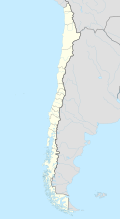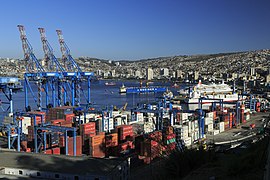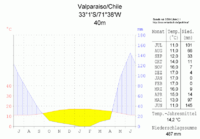Valparaíso
| Valparaíso | |
|---|---|
|
Coordinates: 33 ° 3 ′ S , 71 ° 37 ′ W
Valparaíso on the map of Chile
|
|
|
Location of Valparaíso in Chile
|
|
| Basic data | |
| Country | Chile |
| region | Región de Valparaíso |
| City foundation | 1544 |
| Residents | 252,888 (2017) |
| - in the metropolitan area | 901.468 |
| City insignia | |
| Detailed data | |
| surface | 402 km 2 |
| Population density | 685.6 inhabitants / km 2 |
| height | 10 m |
| Post Code | 234 0000 |
| prefix | +56 32 |
| Time zone | UTC −4 |
| City Presidency | Jorge Sharp Fajardo |
| Website | |
| View of Valparaíso with the port in the foreground | |
Valparaíso [ bɑlpɑɾɑˈiso ] ( German Paradiestal ) is a port city in Chile with 252,888 inhabitants. The agglomeration of Valparaísos has 901,468 inhabitants (as of 2017). The city is the seat of the Chilean Congress . Part of the urban area is the group of Desventuradas Islands, more than 1000 km from the city center .
Valparaíso lies on a bay of the Pacific Ocean that is open to the north . The port is one of the most important in the country. The city's character is world-famous and has been the subject of numerous literary , musical and artistic interpretations. The city is considered the cultural capital of Chile. In July 2003, the historic city center with its architecture from the 19th and 20th centuries was declared a World Heritage Site by UNESCO .
geography
The city is located at 33.05 ° south latitude on the Pacific coast, in the southern part of a bay ( Bahía de Valparaíso ), over 120 kilometers west of the capital Santiago de Chile . The inhabitants of the city are called in Spanish Porteños (from Spanish puerto , port). On the north side of the bay is the city of Viña del Mar , a fashionable resort with many high-rise buildings and a casino. The Valparaíso-Viña del Mar agglomeration is the second largest in the country after Santiago de Chile.
climate
The climate in Valparaíso is Mediterranean and very similar to that of San Francisco . Even in summer, the sea location ensures sea winds and moderate temperatures (rarely above 30 ° C). The nights are relatively cool because of the cold water of the Humboldt Current.
history
Pre-colonial
The bay around Valparaíso was populated by the Changos , an ethnic group that engaged in fishing and agriculture.
Colonial times
The bay was discovered in 1536 by the Spaniard Juan de Saavedra . His ship was sent by Diego de Almagro . The city was founded in 1544 by Juan Bautista Pastene .
During the colonial period, Valparaíso developed slowly and remained an insignificant fishing village for a long time, which is also due to the numerous attacks by pirates and privateers. On his circumnavigation of the world on December 5, 1578 , Francis Drake attacked the city, captured a ship and plundered the houses.
It was only through the decision of the Chilean Congress of February 21, 1811 to open the port of Valparaíso "to free trade with the foreign powers, friends and allies of Spain as well as the neutral powers" that the city's economic development accelerated.
Chilean independence
Before the opening of the Panama Canal , Valparaíso was the first major port that ships reached after bypassing Cape Horn . Therefore, in the 19th century, the city's port was the dominant one on the southern Pacific and, along with San Francisco, one of the two most important ports on the west coast of America . Parts of the city center were created by landfills in the sea.
The city was damaged by earthquakes several times, including in 1822 and 1851 . In the period from 1850 to 1860, the city's stock exchange, the first private bank in Chile and the fire department were founded. The railway connection to the capital Santiago de Chile will be opened in the same period.
On March 31, 1866, the city was bombed in the Spanish-South American War by a Spanish fleet , which was under the command of Admiral Méndez Núñez . The frigates Numanci , Blanca , Villa Madrid , Resolución and Vencedora shelled the city for around three hours, firing around 2,600 shells. The city was badly destroyed. The attack on the unpaved Valparaiso sparked violent international protests.
As early as 1885, Valparaíso had 115,147 inhabitants, including around 10,000 foreigners. On August 11, 1888, the Mena dam broke , and around 100 people died as a result of the tidal wave. On August 16, 1906, another strong earthquake and subsequent tsunami shook the city. The buildings near the coastline today date almost exclusively from the time after this quake.
With the opening of the Panama Canal for regular shipping in 1920, the port lost its importance. In the same year Valparaíso had 182,422 inhabitants.
Military coup
The 1973 military coup in Chile began in the port of Valparaíso, and Allende's body was buried immediately after his death, initially secretly, in the nearby Viña del Mar cemetery.
At the end of the Pinochet era, the Chilean National Congress was moved to the city. Every year on May 21st, the country’s president speaks to Congress. There are regular street battles between left-wing demonstrators and the police.
21st century
At the end of February 2010, the city was hit by an earthquake that also damaged the port, the industrial park and important fiber-optic communications links to Chile.
On April 12, 2014, a major fire broke out on the outskirts of the port city. The fire destroyed around 2900 buildings and an area of 965 hectares; at least 15 people were killed. There was a fire in twelve parts of the city and many residents suffered breathing problems from the ashes. A state of emergency was declared over the city and 12,500 residents were evacuated. The fire was only under control after more than a week. According to eyewitnesses, the cause of the fire are two vultures that landed on a high-voltage power line and, together with the wind, caused the wires to collapse. Sparks (glowing metal) would have ignited dry leaves on a 30 hectare garbage dump on the highway.
As a result of the severe earthquake on September 16, 2015 at 7:54 p.m. local time off Chile, the Congress in Valparaíso was evacuated. On January 2, 2017, a fire destroyed 222 houses in the port district.
Economy, transport and education
Valparaíso's port is one of the most important ports in South America. In the 19th century, Valparaíso was the largest port in the entire Pacific region for decades. After the opening of the Panama Canal in 1914, however, its importance rapidly declined. Today it is not even the largest port in Chile. Today, more tonnage is handled in the neighboring town of San Antonio than in Valparaíso, mainly imported goods for Santiago . Most exports, on the other hand, are decentralized via a number of ports near the copper mines in the I and II regions . The headquarters of the Chilean Navy is located in the city .
The Valparaíso trolleybus has been operating in the city since 1952 and is the only trolleybus operation in the country today. On the railway line to Santiago de Chile there has been no continuous passenger traffic since 1990, but it has been used by the Valparaíso Metro , which is actually an S-Bahn company, since 2005 to Limache . For this operation, the Puerto-Limache section was expanded to double-track again. The Valparaíso Metro is the first local public transport company in Chile to allow bicycles to be taken on weekends and public holidays.
There are several colleges in the city, including the Technical University, Universidad Técnica Federico Santa María , the Catholic University of Pontificia Universidad Católica de Valparaíso , the State Universidad de Valparaíso, and the Universidad de Playa Ancha de Ciencias de la Educación . Valparaíso is therefore also an important educational center in Chile. In 1949 the fraternity of Ripuaria was founded, a student association of German tradition.
Attractions
In the city, which extends over a multitude of hills ( Cerros ), there are numerous old-style buildings. The old town district and the adjoining picturesque hills Cerro Alegre and Cerro Concepción are popular places of residence for artists and students. There are also many cafes, pubs, restaurants and hotels as well as smaller boutiques.
The Chilean national poet Pablo Neruda , who lived in Valparaíso and whose last place of work today houses the Neruda Museum “La Sebastiana”, was fascinated by the city's countless stairs. The 16 surviving ascensores - lifts or funiculars lead to the most important hills. Around 30 systems were built and nine were in operation at the beginning of 2017.
Other attractions include the Maritime and Marine Museum, the Centro Cultural, which is housed in a former prison, and the Museo de Bellas Artes.
Town twinning
Valparaíso has partnerships with the following cities:
-
Rosario Argentina

-
Shanghai People's Republic of China

-
Malacca Malaysia

-
Novorossiysk Russia

-
Oviedo in Asturias Spain

-
Busan South Korea , since 1999

-
Long Beach United States

sons and daughters of the town
- Diego Dublé Almeida (1841–1922), general and politician
- Cosme San Martín (1849–1906), painter
- Alberto Orrego Luco (1854–1931), painter
- Ramón Subercaseaux Vicuña (1854–1937), painter, politician and diplomat
- Alfredo Valenzuela Puelma (1856–1909), painter
- Arnold Diestel (1857–1924), Hamburg Senator and Mayor from 1920 to 1924
- Alfredo Helsby (1862–1933), painter
- Friedrich Matthaei (1865–1930), gynecologist in Hamburg
- Chris Watson (1867–1941), Australian Labor politician and the country's 3rd Prime Minister
- Julio Fossa Calderón (1874–1946), painter
- Wilhelm Münnich (1876–1948), doctor and intendent of the Valparaíso province
- Rodolfo Hammersley (1889–?), Track and field athlete
- Camilo Mori (1896–1973), painter
- Juan Santiago Garrido (1902–1994), composer and musicologist
- Pablo Garrido (1905–1982), composer and jazz musician
- Salvador Allende (1908–1973), doctor and socialist politician, President of Chile from 1970 to 1973
- Augusto Pinochet (1915-2006), general under Allende; Putschist, dictator from 1973 to 1990
- Evelyn Ankers (1918–1985), British actress
- Ricardo Krebs (1918–2011), Chilean historian of German origin
- Eduardo Maturana (1920–2003), composer
- Arno Görke (1923–1992), German stage and television actor and comedian
- Sergio Otoniel Contreras Navia (1926–2019), Catholic clergyman, Bishop of Temuco
- Manfred Max-Neef (1932–2019), economist
- Eduardo Vargas Herrera (1933–1996), architect
- Claudio Bravo (1936–2011), painter
- Gaston Salvatore (1941–2015), German-speaking writer of Chilean origin
- Álvaro Peña-Rojas (* 1943), singer and songwriter
- Omar Saavedra Santis (* 1944), writer
- Elías Figueroa (* 1946), football player
- Valeria Sarmiento (* 1948), film director and film editor, widow of Raúl Ruiz
- Roberto Ampuero (* 1953), writer, columnist and university professor
- Gonzalo Arturo Bravo Álvarez (* 1962), Roman Catholic clergyman, Bishop of San Felipe
- Rodrigo González (* 1968), member of the German band "Die Ärzte"
- Carolina Vera Squella (* 1973), German-speaking actress of Chilean origin
- David Pizarro (* 1979), football player
- Franz Schultz (* 1991), soccer player
Trivia
- The El Mercurio de Valparaíso newspaper is the oldest Spanish-language newspaper.
- A description of the city can be found in the song of the same name by Osvaldo Rodríguez .
- The documentary filmmaker Joris Ivens made a film about Valparaíso in 1963.
- Reinhard Mey mentions Valparaíso in the songs Dieter Malinek, Ulla and I and Frei! and Katja Ebstein in The Great Don Antonio .
- GG Anderson dedicated the Schlager Engel von Valparaíso to a woman from Valparaíso in 1991 .
- Sting wrote and composed the song Valparaíso in 1996 .
- Jules Verne mentions Valparaíso in many novels.
- Valparaíso is also mentioned in Thomas Mann's Buddenbrooks . That was where the young Christian Buddenbrook ended up.
- The novel Die Große Stadt (La ciudad grande) by the exile writer Omar Saavedra Santis, who lives in Germany , is set in Valparaíso, although the name of the city is not mentioned.
- HP Lovecraft mentions Valparaíso in some of his writings.
- Valparaíso is a multiplayer map in the 2010 first-person shooter Battlefield: Bad Company 2 .
- On July 6, 2010, a deep-sea merchant ship ran aground not far from the port on the city's shoreline.
Web links
- Entry on the UNESCO World Heritage Center website ( English and French ).
- History of the German Valparaíso School Overseas communities have shaped Valparaíso's history, here is an example.
- Valparaíso - The City of Elevators on YouTube 360 ° - GEO Reportage, Arte, 2015
Individual evidence
- ^ Süddeutsche.de: Feuerwalze claims deaths in Valparaíso on April 13, 2014
- ↑ Zeit Online: Dead and Destruction by Fire in Valparaíso from April 13, 2014
- ↑ http://orf.at/stories/2226180/2226181/ Deletion work could still take days ORF.at from April 14, 2014
- ↑ http://orf.at/#/stories/2299304/ Tsunami warning after a severe earthquake off Chile, orf.at, September 17, 2015, accessed on September 17, 2015.
- ↑ Major fire in Chile: More than 220 houses destroyed in fire in Valparaíso . In: Neue Zürcher Zeitung . January 4, 2017, ISSN 0376-6829 ( nzz.ch ).
- ↑ http://www.reuters.com/news/picture/stranded-ships?articleId=USRTX256SF Reuters.com: Stranded ships: Waves batter a merchant vessel stranded ..., July 6, 2010, accessed February 3, 2016 .















